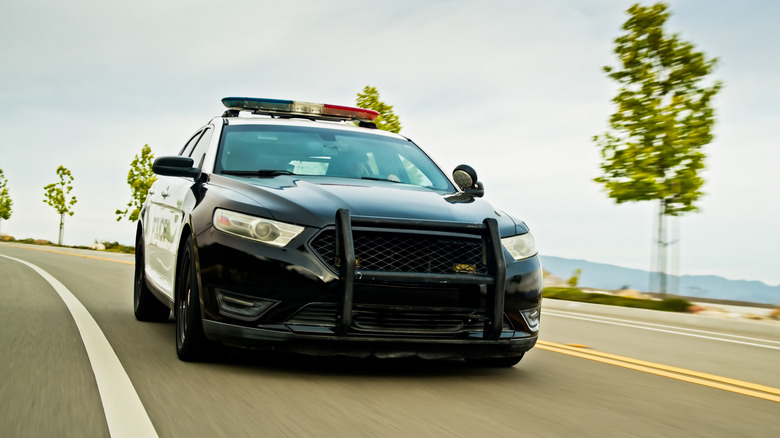Why Do Police Cars Have Bull Bars In Front?
The first horseless patrol vehicle was an electric "paddy wagon" complete with headlights, a stretcher, a cage for prisoners, and a gong that acted as a siren. It appeared on the "mean" streets of Akron, Ohio, in 1899. One of the first official motorized "police cars" wouldn't appear for another decade, when, in 1909, Police Commissioner Frank Croul in Detroit bought a Packard for $350 using his own money.
In the century-plus since then, everything from American-made Ford and Chevy to Chrysler, Plymouth, and Dodge have been made into police cars. And believe it or not, foreign built Volkswagen Bugs, Porsches, Lamborghinis, and other high end sports cars from around the world have been used as police vehicles as well, all in an effort to keep pace with evolving technology.
Part of that evolution includes the equipment (inside and out) they're outfitted with. Bull bars are also called push bars, rambars, and nudge bars. They also go by push bumpers, grille guards, and brush guards, but they all refer to the special attachment seen on the front bumper of many of today's police vehicles.
The idea behind the "bull" bar harkens all the way back to the Wild West when trains were still the fastest way to move around the fledgling United States. Cowcatchers were the angled assemblies attached to the front of these steel beasts and used to push debris and cattle (i.e., bulls), so the train wouldn't derail and kept moving on down the track. A police bull bar is basically used for the same thing, albeit with some different twists.
Pushing and shoving are all part of the bull bars' job
During the evolution of the police car, vehicles from the 1940s and 50s were outfitted with modified and enhanced front bumpers capable of pushing extra weight around. That eventually gave way to an exterior aftermarket rig that attached directly to the chassis.
The first external bars were added to 20 Ford Mustangs with Special Service Packages (SSP) used by the Arizona Highway Patrol in 1988, and not the famous Crown Victoria that so many people associate with police cars ... so bull bars are actually a more recent innovation.
In essence, the modern-day bull bar is used to do very much the same thing as the Old West cowcatcher in that it allows officers to move things, like stalled vehicles or hazardous debris (perhaps after a storm or accident). The bars help reduce any damage the police car might incur while doing so.
Additionally, the bull bar also allows police to perform a Precision Immobilization Technique (PIT) maneuver. This vehicle chase technique was first used by the Fairfax (Virginia) County Police Department in the 1980s to help them disable a fleeing vehicle. To be successfully executed, the driver must apply lateral pressure to the rear quarter panel of the fleeing vehicle to make it spin out predictably, thus making it a "precision technique."
The bull bar has as many detractors as proponents, primarily due to safety concerns for both the officer and the community. A study released in 2012 deemed it to be a damage multiplier capable of inducing more serious accidents, and its use has since been restricted by many cities and agencies globally.
